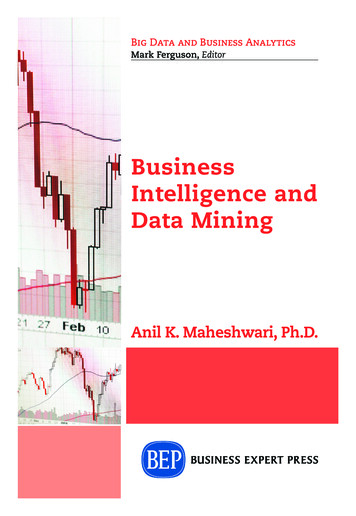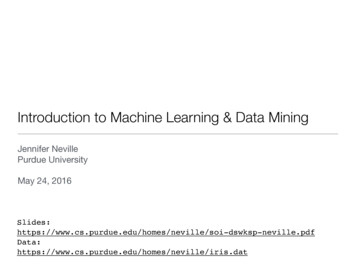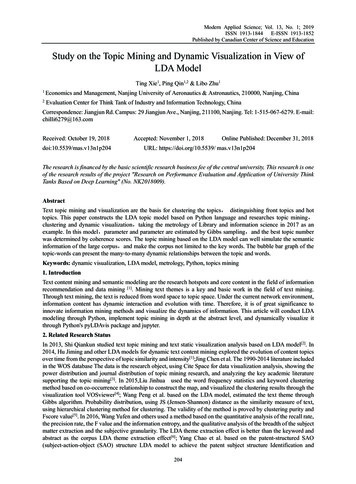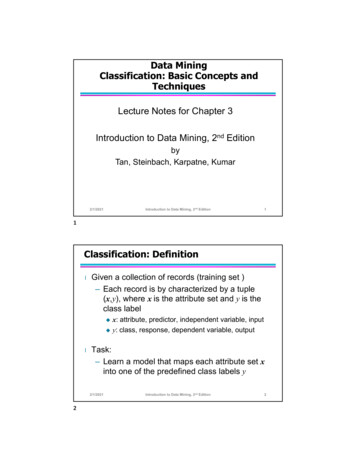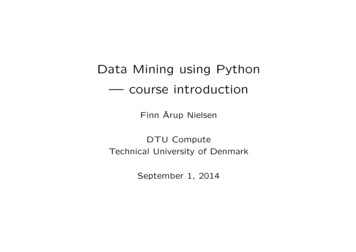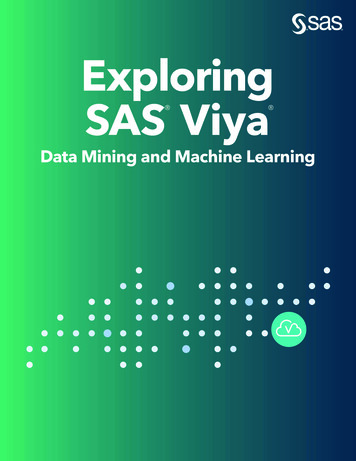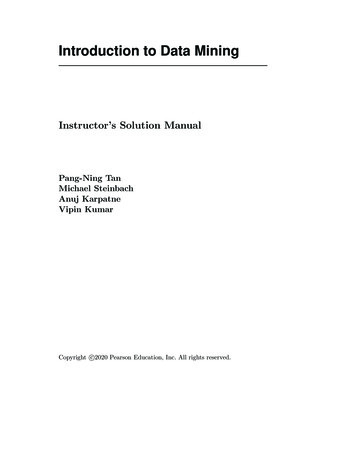
Transcription
Data MiningThe TextbookAggarwalCharu C. AggarwalAbout the BookThis textbook explores the different aspects of data mining from the fundamentals to the complex data types and their applications, capturing the wide diversity of problem domains fordata mining issues. It goes beyond the traditional focus on data mining problems to introduceadvanced data types such as text, time series, discrete sequences, spatial data, graph data, andsocial networks. Until now, no single book has addressed all these topics in a comprehensive andintegrated way. The chapters of this book fall into one of three categories: Fundamental chapters: Data mining has four main problems, which correspond toclustering, classification, association pattern mining, and outlier analysis. These chapterscomprehensively discuss a wide variety of methods for these problems. Domain chapters: These chapters discuss the specific methods used for different domainsof data such as text data, time-series data, sequence data, graph data, and spatial data. Application chapters: These chapters study important applications such as stream mining,Web mining, ranking, recommendations, social networks, and privacy preservation. Thedomain chapters also have an applied flavor.About the AuthorCharu C. Aggarwal is a Distinguished Research Staff Member (DRSM) at the IBM T.J. WatsonResearch Center in Yorktown Heights, New York. He completed his B.S. from IIT Kanpur in 1993and his Ph.D. from the Massachusetts Institute of Technology in 1996. He has published morethan 250 papers in refereed conferences and journals and authored over 80 patents. He is theauthor or editor of 14 books, including the first comprehensive book on outlier analysis, whichis written from a computer science point of view. Because of the commercialvalue of his patents, he has thrice been designated a Master Inventor at IBM. Hehas won multiple awards, chaired conferences, and currently serves on severaljournal editorial boards. He is a fellow of the ACM and the IEEE, for “contributions to knowledge discovery and data mining algorithms.”Computer ScienceISBN 978-3-319-14141-19783319 1414111Data MiningAppropriate for both introductory and advanced data mining courses, Data Mining: The Textbook balances mathematical details and intuition. It contains the necessary mathematical detailsfor professors and researchers, but it is presented in a simple and intuitive style to improve accessibility for students and industrial practitioners (including those with a limited mathematicalbackground). Numerous illustrations, examples, and exercises are included, with an emphasison semantically interpretable examples.Charu C. AggarwalDataMiningThe Textbook
Computers connected to subscribing institutions candownload book from the following clickable 14142-8Data Mining: The TextbookCharu C. AggarwalIBM T. J. Watson Research CenterYorktown Heights, New YorkMarch 8, 2015
Computers connected to subscribing institutions candownload book from the following clickable 14142-8ii
Computers connected to subscribing institutions candownload book from the following clickable 14142-8To my wife Lata,and my daughter Sayaniiii
Computers connected to subscribing institutions candownload book from the following clickable 14142-8iv
Computers connected to subscribing institutions candownload book from the following clickable 14142-8Contents1 An Introduction to Data Mining1.1 Introduction . . . . . . . . . . . . . . . . . . . . . . . . . . . . .1.2 The Data Mining Process . . . . . . . . . . . . . . . . . . . . .1.2.1 The Data Preprocessing Phase . . . . . . . . . . . . . .1.2.2 The Analytical Phase . . . . . . . . . . . . . . . . . . .1.3 The Basic Data Types . . . . . . . . . . . . . . . . . . . . . . .1.3.1 Non-dependency Oriented Data . . . . . . . . . . . . . .1.3.1.1 Quantitative Multidimensional Data . . . . . .1.3.1.2 Categorical and Mixed Attribute Data . . . . .1.3.1.3 Binary and Set Data . . . . . . . . . . . . . . .1.3.1.4 Text Data . . . . . . . . . . . . . . . . . . . .1.3.2 Dependency Oriented Data . . . . . . . . . . . . . . . .1.3.2.1 Time-Series Data . . . . . . . . . . . . . . . .1.3.2.2 Discrete Sequences and Strings . . . . . . . . .1.3.2.3 Spatial Data . . . . . . . . . . . . . . . . . . .1.3.2.4 Network and Graph Data . . . . . . . . . . . .1.4 The Major Building Blocks: A Bird’s Eye View . . . . . . . . .1.4.1 Association Pattern Mining . . . . . . . . . . . . . . . .1.4.2 Data Clustering . . . . . . . . . . . . . . . . . . . . . . .1.4.3 Outlier Detection . . . . . . . . . . . . . . . . . . . . . .1.4.4 Data Classification . . . . . . . . . . . . . . . . . . . . .1.4.5 Impact of Complex Data Types on Problem Definitions1.4.5.1 Pattern Mining with Complex Data Types . .1.4.5.2 Clustering with Complex Data Types . . . . .1.4.5.3 Outlier Detection with Complex Data Types .1.4.5.4 Classification with Complex Data Types . . .1.5 Scalability Issues and the Streaming Scenario . . . . . . . . . .1.6 A Stroll through some Application Scenarios . . . . . . . . . .1.6.1 Store Product Placement . . . . . . . . . . . . . . . . .1.6.2 Customer Recommendations . . . . . . . . . . . . . . .1.6.3 Medical Diagnosis . . . . . . . . . . . . . . . . . . . . .1.6.4 Web Log Anomalies . . . . . . . . . . . . . . . . . . . .1.7 Summary . . . . . . . . . . . . . . . . . . . . . . . . . . . . . .1.8 Bibliographic Notes . . . . . . . . . . . . . . . . . . . . . . . . .1.9 Exercises . . . . . . . . . . . . . . . . . . . . . . . . . . . . . 2222232324
Computers connected to subscribing institutions candownload book from the following clickable 14142-8CONTENTSvi2 Data Preparation2.1 Introduction . . . . . . . . . . . . . . . . . . . . . . . . . . . . . . . . . .2.2 Feature Extraction and Portability . . . . . . . . . . . . . . . . . . . . .2.2.1 Feature Extraction . . . . . . . . . . . . . . . . . . . . . . . . . .2.2.2 Data Type Portability . . . . . . . . . . . . . . . . . . . . . . . .2.2.2.1 Numeric to Categorical Data: Discretization . . . . . .2.2.2.2 Categorical to Numeric Data: Binarization . . . . . . .2.2.2.3 Text to Numeric Data . . . . . . . . . . . . . . . . . . .2.2.2.4 Time Series to Discrete Sequence Data . . . . . . . . .2.2.2.5 Time Series to Numeric Data . . . . . . . . . . . . . . .2.2.2.6 Discrete Sequence to Numeric Data . . . . . . . . . . .2.2.2.7 Spatial to Numeric Data . . . . . . . . . . . . . . . . .2.2.2.8 Graphs to Numeric Data . . . . . . . . . . . . . . . . .2.2.2.9 Any Type to Graphs for Similarity-based Applications .2.3 Data Cleaning . . . . . . . . . . . . . . . . . . . . . . . . . . . . . . . .2.3.1 Handling Missing Entries . . . . . . . . . . . . . . . . . . . . . .2.3.2 Handling Incorrect and Inconsistent Entries . . . . . . . . . . . .2.3.3 Scaling and Normalization . . . . . . . . . . . . . . . . . . . . . .2.4 Data Reduction and Transformation . . . . . . . . . . . . . . . . . . . .2.4.1 Sampling . . . . . . . . . . . . . . . . . . . . . . . . . . . . . . .2.4.1.1 Sampling for Static Data . . . . . . . . . . . . . . . . .2.4.1.2 Reservoir Sampling for Data Streams . . . . . . . . . .2.4.2 Feature Subset Selection . . . . . . . . . . . . . . . . . . . . . . .2.4.3 Dimensionality Reduction with Axis Rotation . . . . . . . . . . .2.4.3.1 Principal Component Analysis . . . . . . . . . . . . . .2.4.3.2 Singular Value Decomposition . . . . . . . . . . . . . .2.4.3.3 Latent Semantic Analysis . . . . . . . . . . . . . . . . .2.4.3.4 Applications of PCA and SVD . . . . . . . . . . . . . .2.4.4 Dimensionality Reduction with Type Transformation . . . . . . .2.4.4.1 Haar Wavelet Transform . . . . . . . . . . . . . . . . .2.4.4.2 Multidimensional Scaling . . . . . . . . . . . . . . . . .2.4.4.3 Spectral Transformation and Embedding of Graphs . .2.5 Summary . . . . . . . . . . . . . . . . . . . . . . . . . . . . . . . . . . .2.6 Bibliographic Notes . . . . . . . . . . . . . . . . . . . . . . . . . . . . . .2.7 Exercises . . . . . . . . . . . . . . . . . . . . . . . . . . . . . . . . . . 9414545464752545657573 Similarity and Distances3.1 Introduction . . . . . . . . . . . . . . . . . . . . . . . .3.2 Multidimensional Data . . . . . . . . . . . . . . . . . .3.2.1 Quantitative Data . . . . . . . . . . . . . . . .3.2.1.1 Impact of Domain-specific Relevance .3.2.1.2 Impact of High Dimensionality . . . .3.2.1.3 Impact of Locally Irrelevant Features3.2.1.4 Impact of Different Lp -norms . . . . .3.2.1.5 Match-based Similarity Computation3.2.1.6 Impact of Data Distribution . . . . .3.2.1.7 Nonlinear Distributions: ISOMAP . .3.2.1.8 Impact of Local Data Distribution . .3.2.1.9 Computational Considerations . . . .3.2.2 Categorical Data . . . . . . . . . . . . . . . . .3.2.3 Mixed Quantitative and Categorical Data . . .595960606161626364656667696970.
Computers connected to subscribing institutions candownload book from the following clickable 1828384854 Association Pattern Mining4.1 Introduction . . . . . . . . . . . . . . . . . . . . . . . . . . . . . . . . . . . .4.2 The Frequent Pattern Mining Model . . . . . . . . . . . . . . . . . . . . . .4.3 Association Rule Generation Framework . . . . . . . . . . . . . . . . . . . .4.4 Frequent Itemset Mining Algorithms . . . . . . . . . . . . . . . . . . . . . .4.4.1 Brute Force Algorithms . . . . . . . . . . . . . . . . . . . . . . . . .4.4.2 The Apriori Algorithm . . . . . . . . . . . . . . . . . . . . . . . . . .4.4.2.1 Efficient Support Counting . . . . . . . . . . . . . . . . . .4.4.3 Enumeration-Tree Algorithms . . . . . . . . . . . . . . . . . . . . . .4.4.3.1 Enumeration-Tree-based Interpretation of Apriori . . . . .4.4.3.2 TreeProjection and DepthProject . . . . . . . . . . . . . .4.4.3.3 Vertical Counting Methods . . . . . . . . . . . . . . . . . .4.4.4 Recursive Suffix-based Pattern Growth Methods . . . . . . . . . . .4.4.4.1 Implementation with Arrays but no Pointers . . . . . . . .4.4.4.2 Implementation with Pointers but no FP-Tree . . . . . . .4.4.4.3 Implementation with Pointers and FP-Tree . . . . . . . . .4.4.4.4 Trade-offs with Different Data Structures . . . . . . . . . .4.4.4.5 Relationship between FP-growth and Enumeration-TreeMethods . . . . . . . . . . . . . . . . . . . . . . . . . . . .4.5 Alternative Models: Interesting Patterns . . . . . . . . . . . . . . . . . . . .4.5.1 Statistical Coefficient of Correlation . . . . . . . . . . . . . . . . . .4.5.2 χ2 Measure . . . . . . . . . . . . . . . . . . . . . . . . . . . . . . . .4.5.3 Interest Ratio . . . . . . . . . . . . . . . . . . . . . . . . . . . . . . .4.5.4 Symmetric Confidence Measures . . . . . . . . . . . . . . . . . . . .4.5.5 Cosine Coefficient on Columns . . . . . . . . . . . . . . . . . . . . .4.5.6 Jaccard Coefficient and the Min-hash Trick . . . . . . . . . . . . . .4.5.7 Collective Strength . . . . . . . . . . . . . . . . . . . . . . . . . . . .4.5.8 Relationship to Negative Pattern Mining . . . . . . . . . . . . . . .4.6 Useful Meta-Algorithms . . . . . . . . . . . . . . . . . . . . . . . . . . . . .4.6.1 Sampling Methods . . . . . . . . . . . . . . . . . . . . . . . . . . . 3.73.83.9Text Similarity Measures . . . . . . . . . . . . . . . . . . . . .3.3.1 Binary and Set Data . . . . . . . . . . . . . . . . . . . .Temporal Similarity Measures . . . . . . . . . . . . . . . . . . .3.4.1 Time-Series Similarity Measures . . . . . . . . . . . . .3.4.1.1 Impact of Behavioral Attribute Normalization3.4.1.2 Lp -norm . . . . . . . . . . . . . . . . . . . . .3.4.1.3 Dynamic Time Warping Distance . . . . . . .3.4.1.4 Window-based Methods . . . . . . . . . . . . .3.4.2 Discrete Sequence Similarity Measures . . . . . . . . . .3.4.2.1 Edit Distance . . . . . . . . . . . . . . . . . . .3.4.2.2 Longest Common Subsequence . . . . . . . . .Graph Similarity Measures . . . . . . . . . . . . . . . . . . . .3.5.1 Similarity between Two Nodes in a Single Graph . . . .3.5.1.1 Structural Distance-based Measure . . . . . . .3.5.1.2 Random Walk-based Similarity . . . . . . . . .3.5.2 Similarity between Two Graphs . . . . . . . . . . . . . .Supervised Similarity Functions . . . . . . . . . . . . . . . . . .Summary . . . . . . . . . . . . . . . . . . . . . . . . . . . . . .Bibliographic Notes . . . . . . . . . . . . . . . . . . . . . . . . .Exercises . . . . . . . . . . . . . . . . . . . . . . . . . . . . . .vii.113115116116117117118118119120120120
Computers connected to subscribing institutions candownload book from the following clickable 45 Association Pattern Mining: Advanced Concepts5.1 Introduction . . . . . . . . . . . . . . . . . . . . . . . . . .5.2 Pattern Summarization . . . . . . . . . . . . . . . . . . .5.2.1 Maximal Patterns . . . . . . . . . . . . . . . . . .5.2.2 Closed Patterns . . . . . . . . . . . . . . . . . . . .5.2.3 Approximate Frequent Patterns . . . . . . . . . . .5.2.3.1 Approximation in Terms of Transactions5.2.3.2 Approximation in Terms of Itemsets . . .5.3 Pattern Querying . . . . . . . . . . . . . . . . . . . . . . .5.3.1 Preprocess-once Query-many Paradigm . . . . . .5.3.1.1 Leveraging the Itemset Lattice . . . . . .5.3.1.2 Leveraging Data Structures for Querying5.3.2 Pushing Constraints into Pattern Mining . . . . .5.4 Putting Associations to Work: Applications . . . . . . . .5.4.1 Relationship to Other Data Mining Problems . . .5.4.1.1 Application to Classification . . . . . . .5.4.1.2 Application to Clustering . . . . . . . . .5.4.1.3 Applications to Outlier Detection . . . .5.4.2 Market Basket Analysis . . . . . . . . . . . . . . .5.4.3 Demographic and Profile Analysis . . . . . . . . .5.4.4 Recommendations and Collaborative Filtering . . .5.4.5 Web Log Analysis . . . . . . . . . . . . . . . . . .5.4.6 Bioinformatics . . . . . . . . . . . . . . . . . . . .5.4.7 Other Applications for Complex Data Types . . .5.5 Summary . . . . . . . . . . . . . . . . . . . . . . . . . . .5.6 Bibliographic Notes . . . . . . . . . . . . . . . . . . . . . .5.7 Exercises . . . . . . . . . . . . . . . . . . . . . . . . . . 391391401401401401411411411421436 Cluster Analysis6.1 Introduction . . . . . . . . . . . . . . . . . . . . .6.2 Feature Selection for Clustering . . . . . . . . . .6.2.1 Filter Models . . . . . . . . . . . . . . . .6.2.1.1 Term Strength . . . . . . . . . .6.2.1.2 Predictive Attribute Dependence6.2.1.3 Entropy . . . . . . . . . . . . . .6.2.1.4 Hopkins Statistic . . . . . . . . .6.2.2 Wrapper Models . . . . . . . . . . . . . .6.3 Representative-based Algorithms . . . . . . . . .6.3.1 The k-Means Algorithm . . . . . . . . . .6.3.2 The Kernel k-Means Algorithm . . . . . .6.3.3 The k-Medians Algorithm . . . . . . . . .6.3.4 The k-Medoids Algorithm . . . . . . . . .6.4 Hierarchical Clustering Algorithms . . . . . . . .84.9Data Partitioned Ensembles .Generalization to Other Data4.6.3.1 Quantitative Data .4.6.3.2 Categorical Data . .Summary . . . . . . . . . . . . . . .Bibliographic Notes . . . . . . . . . .Exercises . . . . . . . . . . . . . . . . . .Types. . . . . . . . . . . . . . . .
Computers connected to subscribing institutions candownload book from the following clickable 14142-8CONTENTSix6.4.1Bottom-up Agglomerative Methods . . . . . . . . . . . . . . . . . .6.4.1.1 Group-based Statistics . . . . . . . . . . . . . . . . . . .6.4.2 Top-down Divisive Methods . . . . . . . . . . . . . . . . . . . . . .6.4.2.1 Bisecting k-Means . . . . . . . . . . . . . . . . . . . . . .6.5 Probabilistic Model-based Algorithms . . . . . . . . . . . . . . . . . . . .6.5.1 Relationship of EM to k-means and other Representative Methods6.6 Grid-based and Density-based Algorithms . . . . . . . . . . . . . . . . . .6.6.1 Grid-based Methods . . . . . . . . . . . . . . . . . . . . . . . . . .6.6.2 DBSCAN . . . . . . . . . . . . . . . . . . . . . . . . . . . . . . . .6.6.3 DENCLUE . . . . . . . . . . . . . . . . . . . . . . . . . . . . . . .6.7 Graph-based Algorithms . . . . . . . . . . . . . . . . . . . . . . . . . . . .6.7.1 Properties of Graph-based Algorithms . . . . . . . . . . . . . . . .6.8 Nonnegative Matrix Factorization . . . . . . . . . . . . . . . . . . . . . . .6.8.1 Comparison with Singular Value Decomposition . . . . . . . . . .6.9 Cluster Validation . . . . . . . . . . . . . . . . . . . . . . . . . . . . . . .6.9.1 Internal Validation Criteria . . . . . . . . . . . . . . . . . . . . . .6.9.1.1 Parameter Tuning with Internal Measures . . . . . . . . .6.9.2 External Validation Criteria . . . . . . . . . . . . . . . . . . . . . .6.9.3 General Comments . . . . . . . . . . . . . . . . . . . . . . . . . . .6.10 Summary . . . . . . . . . . . . . . . . . . . . . . . . . . . . . . . . . . . .6.11 Bibliographic Notes . . . . . . . . . . . . . . . . . . . . . . . . . . . . . . .6.12 Exercises . . . . . . . . . . . . . . . . . . . . . . . . . . . . . . . . . . . .7 Cluster Analysis: Advanced Concepts7.1 Introduction . . . . . . . . . . . . . . . . . . . . . . . . .7.2 Clustering Categorical Data . . . . . . . . . . . . . . . .7.2.1 Representative-based Algorithms . . . . . . . . .7.2.1.1 k-Modes Clustering . . . . . . . . . . .7.2.1.2 k-Medoids Clustering . . . . . . . . . .7.2.2 Hierarchical Algorithms . . . . . . . . . . . . . .7.2.2.1 ROCK . . . . . . . . . . . . . . . . . .7.2.3 Probabilistic Algorithms . . . . . . . . . . . . . .7.2.4 Graph-based Algorithms . . . . . . . . . . . . . .7.3 Scalable Data Clustering . . . . . . . . . . . . . . . . . .7.3.1 CLARANS . . . . . . . . . . . . . . . . . . . . .7.3.2 BIRCH . . . . . . . . . . . . . . . . . . . . . . .7.3.3 CURE . . . . . . . . . . . . . . . . . . . . . . . .7.4 High-Dimensional Clustering . . . . . . . . . . . . . . .7.4.1 CLIQUE . . . . . . . . . . . . . . . . . . . . . .7.4.2 PROCLUS . . . . . . . . . . . . . . . . . . . . .7.4.3 ORCLUS . . . . . . . . . . . . . . . . . . . . . .7.5 Semisupervised Clustering . . . . . . . . . . . . . . . . .7.5.1 Pointwise Supervision . . . . . . . . . . . . . . .7.5.2 Pairwise Supervision . . . . . . . . . . . . . . . .7.6 Human and Visually Supervised Clustering . . . . . . .7.6.1 Modifications of Existing Clustering Algorithms7.6.2 Visual Clustering . . . . . . . . . . . . . . . . . .7.7 Cluster Ensembles . . . . . . . . . . . . . . . . . . . . .7.7.1 Selecting Different Ensemble Components . . . .7.7.2 Combining Different Ensemble Components . . .7.7.2.1 Hypergraph Partitioning Algorithm . 21
Computers connected to subscribing institutions candownload book from the following clickable 14142-8CONTENTSx7.7.2.2 Meta-clustering Algorithm . . . . . . . . .7.8 Putting Clustering to Work: Applications . . . . . . . . . .7.8.1 Applications to Other Data Mining Problems . . . .7.8.1.1 Data Summarization . . . . . . . . . . . . .7.8.1.2 Outlier Analysis . . . . . . . . . . . . . . .7.8.1.3 Classification . . . . . . . . . . . . . . . . .7.8.1.4 Dimensionality Reduction . . . . . . . . . .7.8.1.5 Similarity Search and Indexing . . . . . . .7.8.2 Customer Segmentation and Collaborative Filtering7.8.3 Text Applications . . . . . . . . . . . . . . . . . . .7.8.4 Multimedia Applications . . . . . . . . . . . . . . . .7.8.5 Temporal and Sequence Applications . . . . . . . . .7.8.6 Social Network Analysis . . . . . . . . . . . . . . . .7.9 Summary . . . . . . . . . . . . . . . . . . . . . . . . . . . .7.10 Bibliographic Notes . . . . . . . . . . . . . . . . . . . . . . .7.11 Exercises . . . . . . . . . . . . . . . . . . . . . . . . . . . .2222222222222222232232232232232242242242242242258 Outlier Analysis8.1 Introduction . . . . . . . . . . . . . . . . . . . . . . . . . . . .8.2 Extreme Value Analysis . . . . . . . . . . . . . . . . . . . . .8.2.1 Univariate Extreme Value Analysis . . . . . . . . . . .8.2.2 Multivariate Extreme Values . . . . . . . . . . . . . .8.2.3 Depth-based Methods . . . . . . . . . . . . . . . . . .8.3 Probabilistic Models . . . . . . . . . . . . . . . . . . . . . . .8.4 Clustering for Outlier Detection . . . . . . . . . . . . . . . . .8.5 Distance-based Outlier Detection . . . . . . . . . . . . . . . .8.5.1 Pruning Methods . . . . . . . . . . . . . . . . . . . . .8.5.1.1 Sampling Methods . . . . . . . . . . . . . . .8.5.1.2 Early Termination Trick with Nested Loops .8.5.2 Local Distance Correction Methods . . . . . . . . . . .8.5.2.1 Local Outlier Factor (LOF) . . . . . . . . . .8.5.2.2 Instance-specific Mahalanobis Distance . . .8.6 Density-based Methods . . . . . . . . . . . . . . . . . . . . .8.6.1 Histogram- and Grid-based Techniques . . . . . . . . .8.6.2 Kernel Density Estimation . . . . . . . . . . . . . . .8.7 Information-Theoretic Models . . . . . . . . . . . . . . . . . .8.8 Outlier Validity . . . . . . . . . . . . . . . . . . . . . . . . . .8.8.1 Methodological Challenges . . . . . . . . . . . . . . .8.8.2 Receiver Operating Characteristic . . . . . . . . . . .8.8.3 Common Mistakes . . . . . . . . . . . . . . . . . . . .8.9 Summary . . . . . . . . . . . . . . . . . . . . . . . . . . . . .8.10 Bibliographic Notes . . . . . . . . . . . . . . . . . . . . . . . .8.11 Exercises . . . . . . . . . . . . . . . . . . . . . . . . . . . . 442452462472482492502502512519 Outlier Analysis: Advanced Concepts9.1 Introduction . . . . . . . . . . . . . . . . . . . .9.2 Outlier Detection with Categorical Data . . . .9.2.1 Probabilistic Models . . . . . . . . . . .9.2.2 Clustering and Distance-based Methods9.2.3 Binary and Set-Valued Data . . . . . .9.3 High-Dimensional Outlier Detection . . . . . .253253254254255256256.
Computers connected to subscribing institutions candownload book from the following clickable 14142-8CONTENTS9.3.19.49.59.69.79.8Grid-based Rare Subspace Exploration . . . . . .9.3.1.1 Modeling Abnormal Lower Dimensional9.3.1.2 Grid Search for Subspace Outliers . . .9.3.2 Random Subspace Sampling . . . . . . . . . . . .Outlier Ensembles . . . . . . . . . . . . . . . . . . . . .9.4.1 Categorization by Component Independence . .9.4.1.1 Sequential Ensembles . . . . . . . . . .9.4.1.2 Independent Ensembles . . . . . . . . .9.4.2 Categorization by Constituent Components . . .9.4.2.1 Model-centered Ensembles . . . . . . .9.4.2.2 Data-centered Ensembles . . . . . . . .9.4.3 Normalization and Combination . . . . . . . . .Putting Outliers to Work: Applications . . . . . . . . . .9.5.1 Quality Control and Fault Detection . . . . . . .9.5.2 Financial Fraud and Anomalous Events . . . . .9.5.3 Web Log Analytics . . . . . . . . . . . . . . . . .9.5.4 Intrusion Detection Applications . . . . . . . . .9.5.5 Biological and Medical Applications . . . . . . .9.5.6 Earth Science Applications . . . . . . . . . . . .Summary . . . . . . . . . . . . . . . . . . . . . . . . . .Bibliographic Notes . . . . . . . . . . . . . . . . . . . . .Exercises . . . . . . . . . . . . . . . . . . . . . . . . . .10 Data Classification10.1 Introduction . . . . . . . . . . . . . . . . . . . . . . . . .10.2 Feature Selection for Classification . . . . . . . . . . . .10.2.1 Filter Models . . . . . . . . . . . . . . . . . . . .10.2.1.1 Gini Index . . . . . . . . . . . . . . . .10.2.1.2 Entropy . . . . . . . . . . . . . . . . . .10.2.1.3 Fisher Score . . . . . . . . . . . . . . .10.2.1.4 Fisher’s Linear Discriminant . . . . . .10.2.2 Wrapper Models . . . . . . . . . . . . . . . . . .10.2.3 Embedded Models . . . . . . . . . . . . . . . . .10.3 Decision Trees . . . . . . . . . . . . . . . . . . . . . . . .10.3.1 Split Criteria . . . . . . . . . . . . . . . . . . . .10.3.2 Stopping Criterion and Pruning . . . . . . . . . .10.3.3 Practical Issues . . . . . . . . . . . . . . . . . . .10.4 Rule-based Classifiers . . . . . . . . . . . . . . . . . . .10.4.1 Rule Generation from Decision Trees . . . . . . .10.4.2 Sequential Covering Algorithms . . . . . . . . . .10.4.2.1 Learn-One-Rule . . . . . . . . . . . . .10.4.3 Rule Pruning . . . . . . . . . . . . . . . . . . . .10.4.4 Associative Classifiers . . . . . . . . . . . . . . .10.5 Probabilistic Classifiers . . . . . . . . . . . . . . . . . .10.5.1 Naive Bayes Classifier . . . . . . . . . . . . . . .10.5.1.1 The Ranking Model for Classification .10.5.1.2 Discussion of the Naive Assumption . .10.5.2 Logistic Regression . . . . . . . . . . . . . . . . .10.5.2.1 Training a Logistic Regression Classifier10.5.2.2 Relationship with Other Linear Models10.6 Support Vector Machines . . . . . . . . . . . . . . . . .xi. . . . . . .Projections. . . . . . . . . . . . . . . . . . . . . . . . . . . . . . . . . . . . . . . . . . . . . . . . . . . . . . . . . . . . . . . . . . . . . . . . . . . . . . . . . . . . . . . . . . . . . . . . . . . . . . . . . . . . . . . . . . . . . . . . 98.
Computers connected to subscribing institutions candownload book from the following clickable 14142-8CONTENTSxii10.6.1 Support Vector Machines for Linearly Separable Data . . . . . . .10.6.1.1 Solving the Lagrangian Dual . . . . . . . . . . . . . . . .10.6.2 Support Vector Machines with Soft Margin for Nonseparable Data10.6.2.1 Comparison with other Linear Models . . . . . . . . . . .10.6.3 Nonlinear Support Vector Machines . . . . . . . . . . . . . . . . .10.6.4 The Kernel Trick . . . . . . . . . . . . . . . . . . . . . . . . . . . .10.6.4.1 Other Applications of Kernel Methods . . . . . . . . . . .10.7 Neural Networks . . . . . . . . . . . . . . . . . . . . . . . . . . . . . . . .10.7.1 Single-Layer Neural Network: The Perceptron . . . . . . . . . . . .10.7.2 Multilayer Neural Networks . . . . . . . . . . . . . . . . . . . . . .10.7.3 Comparing Various Linear Models . . . . . . . . . . . . . . . . . .10.8 Instance-based Learning . . . . . . . . . . . . . . . . . . . . . . . . . . . .10.8.1 Design Variations of Nearest Neighbor Classifiers . . . . . . . . . .10.8.1.1 Unsupervised Mahalanobis Metric . . . . . . . . . . . . .10.8.1.2 Nearest Neighbors with Linear Discriminant Analysis . .10.9 Classifier Evaluation . . . . . . . . . . . . . . . . . . . . . . . . . . . . . .10.9.1 Methodological Issues . . . . . . . . . . . . . . . . . . . . . . . . .10.9.1.1 Holdout . . . . . . . . . . . . . . . . . . . . . . . . . . . .10.9.1.2 Cross-Validation . . . . . . . . . . . . . . . . . . . . . . .10.9.1.3 Bootstrap . . . . . . . . . . . . . . . . . . . . . . . . . . .10.9.2 Quantification Issues . . . . . . . . . . . . . . . . . . . . . . . . . .10.9.2.1 Output as Class Labels . . . . . . . . . . . . . . . . . . .10.9.2.2 Output as Numerical
plex data types and their applications, capturing the wide diversity of problem domains for data mining issues. It goes beyond the traditional focus on data mining problems to introduce advanced data types such as text, time series, discrete sequences, spatial data


